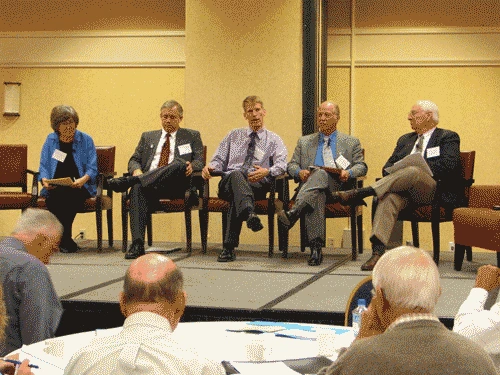Public Policy Review

Goal is common understanding, ongoing dialogue
In my last column, I highlighted the need for broadening and deepening the dialogue on Arizona’s water management challenges. On Friday, Oct. 26 the Tucson region took a step in that direction, with almost 300 people attending a community conversation on water, an event co-organized by the Water Resources Research Center, Southern Arizona Leadership Council, Tucson Regional Town Hall, Arizona Department of Water Resources, Central Arizona Project, Pima Association of Governments, and the Southern Arizona Water Users Association.
We carefully planned the event to accomplish several objectives. First, we wanted to attract individuals who do not spend most of their waking hours thinking about water. Second, we hoped to present basic water information in a way to truly interest the audience, without participants suffering what I call the “glazed-over-eyes syndrome.” Third, we wanted to include different perspectives on important water issues. Fourth, we desired the event to be conversation-friendly. Fifth, we wanted audience input on questions posed to them. We hoped to do all this and more by employing an interesting and lively format!
I am writing this column two days after the event, on a deadline not allowing time to review written comments and responses to our questions. But I have some immediate thoughts to share about the event and its overriding goal of broadening and deepening the water dialogue. It bodes well for the success of the event that our audience was diverse.
Our first panel helped get us on the same page with information about our current water situation, including progress toward meeting the region’s safe-yield goal. Experts included Tucson Active Management Area Director Ken Seasholes, always an excellent source of current information and superb graphics. Our morning panelists encouraged participants to understand that the region’s challenges fit into a broader puzzle. They and keynote speaker Rita Maguire provided the backdrop for the day’s questions, comments, and, at times, debates.
Even lunch was an opportunity to exchange information, with Tucson City Manager Mike Hein and Pima County Administrator Chuck Huckelberry offering their perspectives and fielding questions. In confronting the future of the Tucson region, both underscored the need for coordinated planning and region-wide discussions. Huckelberry discussed the county’s efforts to connect water availability with land-use decision making. In addressing our water conservation ethic, Hein asked the much contemplated question: Why conserve water if we don’t know what we’re conserving for? (Look for more on this topic in my next column!) The need for enlightenment, patience and compromise was stressed. With newspapers tending to focus on local interjurisdictional battles, I was heartened by Huckelberry’s and Hein’s comments; I feel more hopeful that the region’s approach to growth and water issues will not be fragmented.
The seven-member afternoon panel shared its sometimes differing perspectives. Figuring prominently in the discussions were climate change and environmental water needs. Madeline Kiser of Sustainable Tucson stressed the importance of improving access to science as well the need to consider the social and economic costs of actions. Andy Laurenzi noted that transportation infrastructure will play a key role in determining the location of people and businesses. Several called for a paradigm shift in our thinking about the future of the region and state. Climate change, coupled with rapid growth, is clearly increasing people’s awareness of water management and related uncertainties.
The day’s dialogue was truly multi-directional. I look forward to reviewing the audience feedback forms. Participants were asked the following questions: What are the most pressing regional water issues?; What additional water information is needed?; What are the desired outcomes of the meeting?; What type of mechanism do we need to keep the conversation going?; and What message(s) do participants want to convey to regional leaders and decision makers?
I imagine others agree with me that as we devise policy solutions to huge water resource challenges we confront both opportunities and obstacles. Comments about the need for water infrastructure, as well as the fact that water pricing does not reflect resource scarcity, made me think of the possibility of a water use tax, with proceeds going into an infrastructure fund.
Although some shudder at any mention of taxes, it may be time to consider some bold actions to better accommodate the influx of people into the region forecasted by panelist Dave Taylor and others.
The discussion prompted me to think once again about the need for a more diverse economic base. A slump in housing or land development causes the economy of the entire state to suffer significantly. We need to diversify our economic base and recognize that good jobs may be connected to water using activities, like high-tech manufacturing. We should look at an activity’s water use as it relates to community goals before judging its acceptability.
End-of-the-day definitive solutions were not expected, nor even possible after a one-day dialogue. We all know water issues are complex and that water is one part, albeit a very critical part, of a larger puzzle. What we hoped to do was emphasize the importance of a common understanding and an ongoing water dialogue. In that we were successful. I thank all involved.

